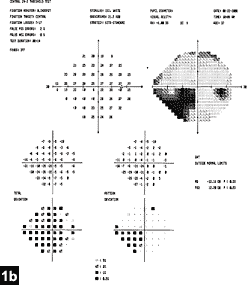Man experiences decreased peripheral vision
Humphrey 24-2 visual fields showed homonymous left inferior quadrantanopia.

A 47-year-old man was seen in the emergency room for decreased left peripheral vision. The visual disturbance had developed insidiously over about 2 weeks. Associated symptoms included a dull frontal headache and photopsias. He denied seeing floaters. On the day of presentation, while trying to make a left turn, a car suddenly appeared in his field of view and the patient narrowly avoided a motor vehicle accident. Later in the day, he saw a woman walking down a staircase holding a young child’s hand. While the patient saw the child’s hand, he could not see the child who was to his left. The patient also noted a sensation of “feeling drunk” despite not consuming alcohol in 21 years. These events prompted the patient to seek medical attention.
 Shazia Ahmed |  My Hanh T. Nguyen |
History
Ocular and medical histories were noncontributory. Family medical history was significant for cerebrovascular accidents and myocardial infarctions in both parents when they were in their 60s and a sister who suffered a myocardial infarction in her 50s.
Examination
On examination, vital signs were normal, and cardiac, pulmonary and musculoskeletal exams were unremarkable. Cranial nerves were intact, and extremity strength and sensation were full and symmetric. There were no cerebellar signs or gait abnormalities.
Visual acuity was 20/25 in both eyes, although the patient noted difficulty seeing the left side of the eye chart. IOP, pupil reactivity and extraocular movements were unremarkable. Confrontation visual fields examination revealed inability to see finger movement in the bilateral left lower visual fields. Humphrey 24-2 visual fields showed homonymous incongruous left inferior quadrantic defects (Figures 1a and 1b).
Slit-lamp examination of the anterior segment revealed no abnormalities in either eye. Fundus examination demonstrated optic discs with sharp borders and normal vasculature. The retina was flat to the ora serrata in both eyes.
|
Images: Chang J, Hedges TR |

What is your diagnosis?
Homonymous quadrantanopia
Homonymous incongruous quadrantanopia (“pie in the floor”) defects localize post-chiasmally along the visual pathway and are generally found in the superior optic radiations of the parietal lobe. The more congruous the defects in the visual fields, the closer the lesions are located to the occipital lobe.
The differential diagnosis for a lesion producing this type of visual field defect includes a thromboembolic event, tumor and demyelinating disease involving the optic tract, lateral geniculate nucleus and visual radiations as well as aneurysm involving the posterior chiasm. Also, arteriovenous malformations, hemorrhagic lesions and abscesses should be considered. The most common etiology is stroke; 90% of isolated homonymous hemianopsias are caused by infarcts.
The patient underwent magnetic resonance imaging that revealed an area of increased signal involving the right hippocampus, thalamus and mesial temporal lobe with fluid attenuated inversion recovery signal extending into the midbrain (Figures 2a and 2b).
Brain biopsy revealed tissue with positive glial fibrillary acidic protein staining and mitoses but no necrosis. The tumor was graded WHO class 3 out of 4, anaplastic astrocytoma.
|
|
|
Discussion
Astrocytomas are primary central nervous system neoplasms derived from immortal glial cells (either fibrillary or protoplasmic astrocytes) and classified according to narrow (pilocytic astrocytoma, subependymal giant cell astrocytoma, pleomorphic xanthoastrocytoma) vs. diffuse (low-grade astrocytoma, anaplastic astrocytoma, glioblastoma) zones of infiltration. WHO class 1 encompasses pilocytic astrocytomas. Low-grade astrocytomas are classified as class 2. Anaplastic astrocytomas are classified as class 3 and glioblastoma multiforme as class 4. Anaplastic astrocytoma is differentiated histologically from glioblastoma multiforme by a lack of necrosis and palisading cells. Life expectancy from time of presentation is 10 years, 5 years, 2.5 years and less than 1 year for classes 1, 2, 3 and 4, respectively.
Like most patients with anaplastic astrocytoma, our patient was not judged to be a good surgical candidate because of the location and extensive nature of the lesion. He is currently undergoing chemotherapy and radiation.
For more information:
- Jeffrey Chang, MD, and Thomas R. Hedges III, MD, can be reached at New England Eye Center, Tufts University School of Medicine, 750 Washington St., Box 450, Boston, MA 02111; 617-636-4219; fax: 617-636-4866; Web site: www.neec.com.
- Edited by Shazia Ahmed, MD, and My Hanh T. Nguyen, MD. Drs. Ahmed and Nguyen can be reached at New England Eye Center, Tufts University School of Medicine, 750 Washington St., Box 450, Boston, MA 02111; 617-636-4219; fax: 617-636-4866; Web site: www.neec.com. Drs. Ahmed and Nguyen have no direct financial interest in the products mentioned in this article, nor are they paid consultants for any companies mentioned.
References:
- Anderson DR, Patella VM. Automated Static Perimetry. St. Louis, MO: Mosby; 1999.
- Frederiksen JL, Larsson HB, et al. Plaques causing hemianopsia or quadrantanopsia in multiple sclerosis identified by MRI and VEP. Acta Ophthalmol. 1991;69(2):169-177.
- Hedges T. Tumors of neuroectodermal origin. In: Miller NR, Newman NJ, eds. Walsh and Hoyt’s Clinical Neuro-Ophthalmology. 5th ed. Baltimore, MD: Williams and Wilkins; 1998:1919-1957.
- Kleihues P, Burger PC, Scheithauer B. The new WHO classification of brain tumors. Brain Pathol. 1993;3(3):255-268.




